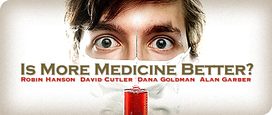Consider a health policy issue like child car seats in the U.S., mosquito netting in the third world, preschool education for poor children, or the immunization of immigrants. Imagine that for this issue there were many good studies over several decades, including some recent studies. Imagine that after controlling for many factors, these studies usually found that variations in spending or usage were significantly, substantially, and positively related to variations in health. Furthermore, imagine this result was confirmed by a thirty year old randomized experiment.
In this situation I predict most health policy experts would clearly and publicly say that we should act now to promote, e.g., child car seats or mosquito netting, via crude policies like subsidies or mandates. Such experts would not say we should wait for more studies to examine other possible explanations, or to better identify more when, e.g., child car seats or mosquito netting are the most useful, to better target policy.
But when many good studies over decades, and a thirty year old randomized experiment, show little or no relation between aggregate variations in health and medical spending, we see a different reaction. None of the diverse health policy experts commenting here or on other blogs will accept my challenge to say clearly to the public “simple crude cuts, such as price increases or spending caps, would produce little or no net health harm.” None will even join my call to redo the thirty year old RAND experiment again today. Instead, they say we should wait to clarify the health-medicine relation, and focus instead on better policies to distinguish helpful from harmful medicine.
When asked what reasons they have for doubting that existing aggregate studies suggest crude medical cuts will not hurt health, the three commentators here at Cato Unbound do not point to the same reasons. At first none of them will even consider simple crude cuts, but when pushed David Cutler suggests aggregate studies are missing important controls (which he does not identify). Alan Garber dismisses simple cuts as politically infeasible, but does seem willing to endorse lower tax-based subsidies. Dana Goldman first points to “the existence of identifiable treatments with positive benefits, which are cut when spending is cut.” Instead of responding to questions about this, he switches to suggesting high spending region doctors have invested more in learning expensive treatments, and when questioned about this he switches to unmeasured differing preferences; “Maybe people in Miami prefer surgery, and people in Minnesota prefer medical management.”
If aggregate studies had suggested medical spending helps health a lot, I can’t imagine health policy experts being nearly as reluctant to endorse simple crude spending increases. This seems a double-standard.

